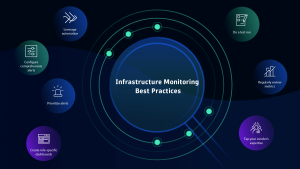As organizations adopt more cloud-native technologies and IT infrastructure is becoming increasingly distributed, organizations must align business objectives and end-user experience with the availability and performance of the IT infrastructure. This shift requires infrastructure monitoring to ensure all your components work together across cloud environments, operating systems, storage, servers, virtualized systems, and more.
What is infrastructure monitoring, then, and why does it matter more than ever for cloud-native architectures? Here’s an introduction to infrastructure monitoring and the business value it delivers, and some best practices to keep in mind when implementing it within your organization.
What is infrastructure monitoring?
Infrastructure monitoring is the process of collecting and analyzing data from IT infrastructure, systems, and processes and using that data to improve business outcomes and drive value across the whole organization.
Simply put, infrastructure monitoring is the oxygen to your infrastructure. It collects all the data needed to provide a complete picture of availability, performance, and resource efficiency so your applications and services remain up and available to your users.
As businesses rely more heavily on applications and services for their revenue streams, system performance has become mission-critical. Millions of people worldwide have recently put a massive strain on these organizations’ digital properties — from unemployment claims and small business loans to telehealth and grocery shopping. The associated applications and services are mission-critical for individuals and organizations alike.
Infrastructure monitoring ensures organizations can respond to issues proactively, preventing loss of time and money. This makes infrastructure monitoring the essence of mission-critical, delivering these key capabilities:
- The ability to optimize business requirements and user experience
- The flexibility and scalability to ingest data from a variety of sources and to handle planned and unplanned traffic spikes
- The ability to detect and alert on outages, resource utilization, and performance degradations to minimize downtime and increase operational efficiency
- Pinpoint root causes to determine precisely where a problem originates in the infrastructure or application
- The ability to drill down into specific faulty infrastructure components and trigger remediation

How Infrastructure Monitoring Works
Infrastructure monitoring typically involves the following steps:
- Data collection: Infrastructure monitoring tools collect data from a variety of sources, including:
- Operating systems
- Hypervisors
- Containers
- Databases
- Network devices
- Applications
- Logs
- Metrics
- Data analysis: Once the data has been collected, it is analyzed to identify trends and patterns. This can be done using a variety of tools and techniques, such as filtering, querying, statistical analysis, machine learning, and anomaly detection.
- Alerting: When the data analysis identifies a potential problem, the monitoring system generates an alert. In addition to being presented in a dashboard, alerts can also be sent to IT staff via email, SMS, or other messaging channels, like Slack or Microsoft Teams.
- Remediation: Once an alert has been received, IT staff can investigate the problem and take steps to resolve it. In more advanced practices, the alert can trigger an automation and open, or update, a ticket with an IT service management (ITSM) solution.
There are two main types of infrastructure monitoring:
- Agent-based monitoring: Agent-based monitoring involves installing a software agent on each system that needs to be monitored. The agent collects data from the system and sends it to the monitoring server. This can include, for example, all requests to an application, service, or host.
- Agentless monitoring: Agentless monitoring does not require the installation of any software agents. Instead, it uses protocols such as SSH, SNMP, and WMI to collect and forward data from systems via exposed remote APIs. Though there can be advantages to this approach, the depth of agentless monitoring is severely reduced.
Challenges of infrastructure monitoring in cloud environments
Modern infrastructure demands modern monitoring, especially when you’re negotiating the unique challenges of multicloud environments, which don’t always enable the level of visibility needed into cloud infrastructure. Monitoring these environments is tricky since each cloud vendor offers native monitoring tools. Juggling multiple monitoring solutions makes it hard for organizations to gain a comprehensive view of their cloud infrastructure.
Your DevOps team may also be struggling with the classic “cattle versus pets” transition to an operational service model where computing assets become an interchangeable resource instead of something unique and irreplaceable. As organizations adopt microservices-based architecture and cloud-native technologies, they are also looking to adopt best practices for managing their new cloud infrastructure so they can provide better service and minimize unplanned downtime.
Infrastructure monitoring provides critical intelligence to help you optimize the health and utilization of these cloud-native environments, ensuring more reliable performance and a high-quality user experience.
What are the benefits of infrastructure monitoring?
Organizations can’t afford to wait for alerts to come in when a system or application component has failed, especially if they plan to honor end-user service level agreements (SLAs). Instead, they need to adopt a proactive posture to identify and resolve potential infrastructure issues before they impact the user experience. Infrastructure monitoring helps organizations achieve this goal by accelerating root cause analysis, which empowers cross-functional teams to effectively collaborate and fix problems before they flare into five-alarm fires.
Infrastructure monitoring also helps organizations analyze performance trends continuously so they can better understand what peak performance looks like, optimize performance where appropriate, and flag potential issues well in advance.
DevOps teams can even leverage infrastructure monitoring as part of their A/B testing experiments. This way, teams can determine upfront how certain features or enhancements will impact application performance down the road. DevOps teams can also utilize infrastructure monitoring to validate deployments.
Your ITOps and SRE teams can also leverage infrastructure monitoring, taking advantage of the automation capabilities in modern infrastructure monitoring tools to achieve end-to-end observability across your entire infrastructure. In doing so, you can consistently deliver on customer expectations, and enable your organization to achieve its most ambitious goals as it continues to scale for growth.
What observability data should you use?
Your infrastructure monitoring will only deliver high-quality insights if you have the right tools with access to the right information. With that in mind, include these types of observability data sources:
- Metrics: Quantitative data is especially useful for creating visualizations and identifying patterns in performance over time. Values represented as counts or measures calculated or aggregated over a time period deliver crucial information for performance and state-based analysis.
- Event logs: Every system and service generates event logs, which can give you insights into what’s happening and aid in troubleshooting.
- Distributed traces: For better insight into how various aspects of your environment interact with one another, capture distributed traces to record the journeys of specific transactions as they make their way through your infrastructure.
- Metadata: Additional information, such as topology details, name spaces, and priority data, will help you understand the significance and impact of events as they interact with other components of your infrastructure.
- UX data: A view into how users are experiencing your site or applications is one of the most important dimensions to understand how your infrastructure is performing. User experience data, such as page load times and latency, will give you better insight into your UX in real-time and empower you to adjust the UX if needed .
- Open-source telemetry: There are many open-source options designed to help you achieve better observability across your entire environment. These industry-standard tools include OpenTelemetry , Prometheus, and StatsD, to name a few.
- Cloud integrations: Modern infrastructure includes cloud infrastructure, which is why cloud integrations, such as CloudWatch for Amazon Web Services (AWS), can be helpful sources of observability data for infrastructure monitoring.
Infrastructure monitoring best practices
Following a few best practices will help you get the most value from your infrastructure monitoring program. For example:
- Leverage automation: Augment your capabilities with infrastructure monitoring tools that feature automation. This will help you gain complete end-to-end observability across the full stack and transition to AIOps for infrastructure monitoring.
- Configure comprehensive alerts: When your alerts are specific, they’re less likely to result in false positives. Comprehensive alerts that provide a certain level of redundancy will be more likely to deliver the heads-up you need in any situation.
- Prioritize alerts: Organize and prioritize notifications so you don’t miss the most important alerts — particularly the ones reporting impacts to the user experience.
- Create role-specific dashboards: Infrastructure monitoring tools allow you to create a range of custom dashboards that various teams within your organization will find useful when monitoring KPIs of importance to them. Set up dashboards for your ITOps teams, your security teams, and business leaders so everyone has access to the insights they need at a glance.
- Do a test run: As with any mission-critical system, you’ll want to make sure your infrastructure monitoring tools are working as expected before you begin to rely on them on a day-to-day basis. Schedule a test run and make sure everything is running according to plan.
- Regularly review metrics: As your business goals change and your infrastructure evolves, so will the metrics and KPIs you need to track. Review them at regular intervals so you don’t unintentionally develop any blind spots across your infrastructure.
- Tap your vendor’s expertise: Struggling to fine-tune or optimize your infrastructure monitoring as your organization digitally transforms? Take full advantage of your infrastructure monitoring vendor’s expertise. They’ve overseen infrastructure monitoring deployments across countless organizations and can help you achieve your monitoring goals faster.
Infrastructure monitoring use cases
Infrastructure monitoring is critical to modern IT operations. Organizations can proactively identify and resolve potential issues before they cause downtime or performance problems, ensuring IT infrastructure operates at peak efficiency.
The most common infrastructure monitoring use cases include the following:
- Detecting and resolving network issues. By monitoring network traffic and other metrics, infrastructure monitoring tools can recognize bottlenecks that affect network performance. This information can help network teams identify the root cause of issues and take corrective action before they affect end users.
- Ensuring compliance and security. Organizations can detect potential security threats and ensure their infrastructure complies with relevant regulations and standards.
- Tracking server health and utilization. These tools can provide real-time insights into the health and utilization of servers, including CPU usage, memory utilization, and disk space. This enables organizations to identify potential issues with server capacity and ensure application performance isn’t affected.
- Capacity planning and optimization. Organizations can identify areas where additional resources may be needed to make informed decisions about how to allocate resources for maximum efficiency involving capacity planning and optimization.
- Monitoring application performance. By monitoring metrics such as response time, transaction volume, and error rates, organizations can detect issues with application performance and resolve them to avoid further complications.
What to look for when selecting an infrastructure monitoring tool
With organizations focusing on modern infrastructure, traditional infrastructure monitoring tools are not going to cut it. An all-in-one approach to monitoring cloud platforms and supporting applications and infrastructure is the best approach. Here are some key attributes to look for:
- All-in-one platform: Break down silos between apps and infrastructure teams with end-to-end visibility across the entire IT stack.
- AI-assistance: Use AI to detect anomalies and benchmark your system. This will allow your IT team to focus on what matters: proactive action, innovation, and business results.
- Contextual information: Go beyond metrics, logs, and traces with UX and topology data to understand billions of interdependencies.
- Root-cause analysis: Get actionable answers to problems in real-time, down to the code level.
- Automation for large-scale dynamic environments: This includes discovery, instrumentation, baselining, agent life-cycle management, and problem analysis.
- End-to-end coverage for hybrid cloud: Gain comprehensive support for multi-cloud, third-party integrations — including public cloud, on-prem virtualization, mainframes, database vendors, etc.
- Cloud-native architectures: These provide support for containers and serverless, including open standard, such as OpenTelemetry, Prometheus, StatsD, and Telegraf.
All-in-one infrastructure monitoring for modern cloud environments
Now more than ever, software needs to run perfectly, and your IT infrastructure should be thought out strategically in the context of the end-user and business. Observability into performance is crucial across the IT stack and can only be achieved through a smart investment in infrastructure monitoring. This helps ensure your organization has a comprehensive look at performance and availability across your entire IT ecosystem.
Dynatrace provides a single-interface platform that delivers all-in-one infrastructure monitoring and end-to-end observability across today’s modern environments — including hybrid cloud and cloud-native architectures, all with contextual insights and precise, AI-driven answers.
With a single source of truth and precise root-cause analysis, your DevOps teams can collaborate more effectively and waste less time. And with observability and automation at scale encompassing your infrastructure, your SREs can evolve ITOps into AIOps, creating valuable capacity to innovate, optimize user experiences, and transform faster.
Infrastructure monitoring should be at the core of any organization’s IT strategy. That’s exactly what Docebo, one of the largest providers of online learning platforms, realized when they decided to use infrastructure monitoring to gain visibility across their entire infrastructure.
Watch the Docebo webinar now!
You can hear the challenges Docebo faced in the cloud and how monitoring their infrastructure helps them make better business decisions in this webinar.





Looking for answers?
Start a new discussion or ask for help in our Q&A forum.
Go to forum